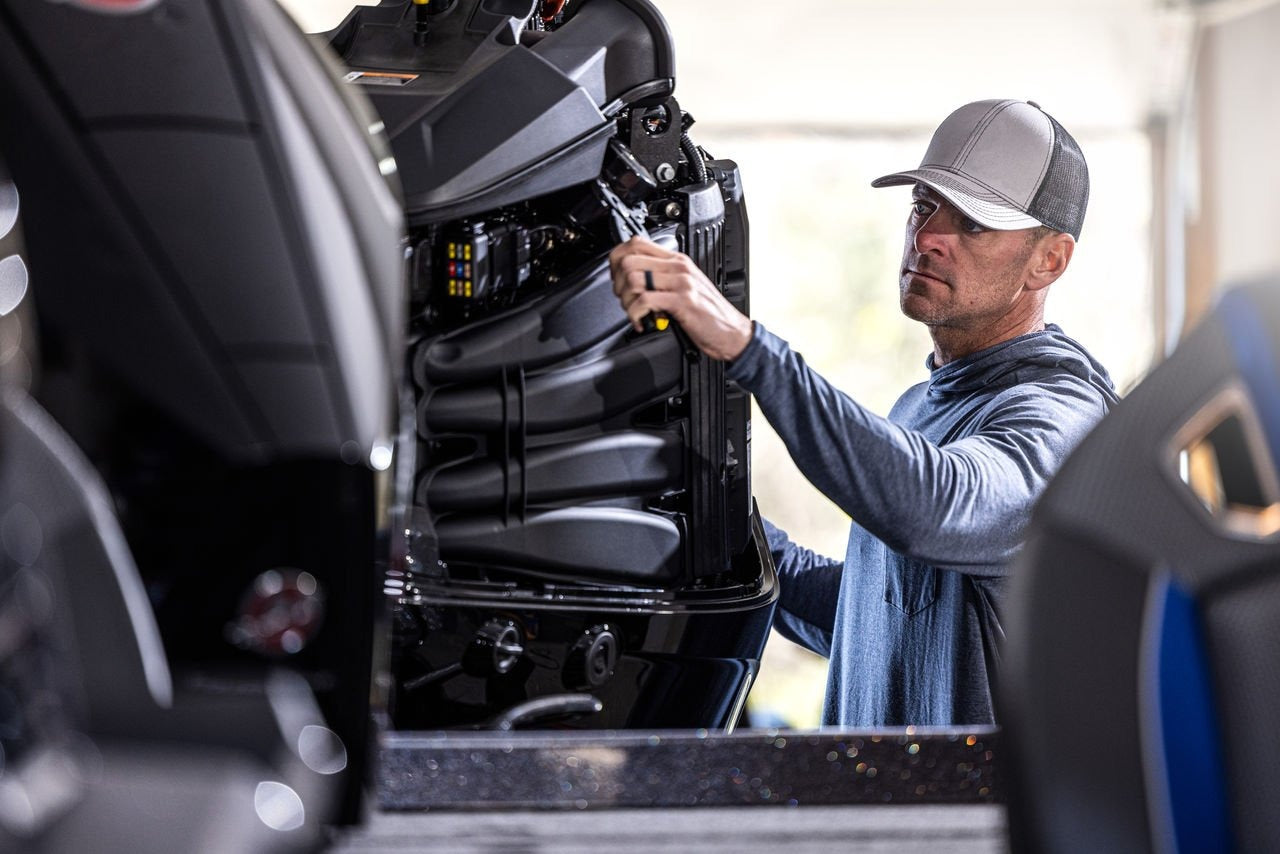When winter creeps in, the smartest boaters spend one calm afternoon preparing their outboard for hibernation. A proper winterization routine keeps fuel fresh, wards off corrosion, protects the gearcase, and all but guarantees an easy first start next spring. Below is a clear, skimmable guide to get it done—plus the routine service habits that keep your engine running stronger, longer.
Shop model-matched maintenance kits and essentials on WakeBoss:
- Mercury 100-Hour Kit (75–115 HP)
- Mercury 300-Hour Kit (40–60 HP)
- Suzuki Maintenance Kit
- Lowest Price Guarantee
Why Winterizing Your Outboard Isn’t Optional
Left untreated, fuel can oxidize and form varnish that gums injectors and carbs. Moisture invites internal corrosion, and old gear lube can hide water intrusion that freezes and cracks components. Winterization stops all of that—so your engine wakes up clean, lubricated, and ready to run when the ice is gone.
Pre-Winterization Checklist
Parts & Supplies
- Fresh engine oil & OEM oil filter (4-stroke)
- Marine gear lube (with new seals/washers)
- Fuel stabilizer (marine-grade)
- Fogging oil or manufacturer-approved storage procedure
- Water-separating fuel filter
- Marine grease for zerks/splines
- Corrosion inhibitor & spare anodes if worn
- Basic tools, drain pan, rags, gloves
Quick add-to-cart: Use the Mercury, Suzuki, and hour-based kits listed above to get everything in one go.
Setup & Safety
- Work in a ventilated space.
- Keep a fire extinguisher nearby when handling fuel.
- Capture and recycle oil/gear lube at an approved facility.
Step-by-Step Outboard Winterization
1) Treat & Circulate Stabilized Fuel
Add the recommended amount of marine fuel stabilizer to fresh gasoline. Run the engine long enough to get stabilized fuel through the entire system—lines, injectors/carb circuits, and rails.
Pro tip: Fill the tank to ~95% to minimize condensation but leave a little expansion room.
2) Change Engine Oil & Filter (4-Stroke)
- Warm the engine (it drains cleaner).
- Drain oil fully.
- Replace the oil filter with an OEM-spec part.
- Refill with the manufacturer-specified oil type and capacity.
- Run briefly and recheck the level.
Grab what you need: Mercury, Suzuki & Yamaha oil change kits on WakeBoss make this painless.
3) Flush the Cooling System & Protect the Powerhead
- Flush: Use clean freshwater to flush mineral/salt deposits.
- Protect for storage: Follow your engine’s storage procedure. Some models use fogging oil via intake; others use a specific storage mode or fuel-system treatment per the owner’s manual. The goal is a protective film on cylinder walls and upper components.
4) Replace Gear Lube (Lower Unit)
- Remove the bottom drain plug first, then the top vent.
- Inspect old lube for milky color (water) or metal shavings.
- Refill from the bottom until lube flows from the top vent; install new seals and torque to spec.
Why it matters: Any water trapped in the gearcase can freeze and cause expensive damage.
5) Inspect Prop & Shaft
- Remove the prop, clean fishing line from the shaft, inspect the seal, and apply a thin coat of marine grease to the splines. Reinstall the prop and secure properly.
6) Grease Zerks & Pivot Points
- Hit steering, tilt/trim, and other zerk fittings with marine grease. Smooth movement now prevents corrosion-related stiffness later.
7) Check Anodes & Apply Corrosion Protection
- Replace sacrificial anodes that are 50% or more consumed.
- Lightly mist exposed metal with a marine corrosion inhibitor (avoid belts and electrical contact points).
8) Battery Care
- Disconnect the negative cable first, then positive.
- Clean terminals and store the battery in a cool, dry spot on a smart maintainer.
- Never store a battery discharged—it shortens its life.
9) Final Storage Setup
- Store the engine vertical so water drains out of cooling passages.
- Keep the cowling on and use a breathable cover to deter dust while avoiding trapped moisture.
- Log what you did (oil hours, filters, anodes) so you’re set for spring.
Regular Maintenance That Pays Off All Season
Hour-Based Service Rhythm (20 / 100 / 300)
Follow your owner’s manual, but many engines follow a 20-hour break-in check, recurring 100-hour/annual service (oil, filter, gear lube, plugs/inspection), and deeper 300-hour items. Hour-matched kits make the right parts easy:
Cooling System & Impeller
Watch the tell-tale stream; a weak or erratic stream can indicate a restricted passage or a tired impeller. Replacing the water-pump impeller at manufacturer intervals protects the powerhead from overheating.
Fuel Quality & Filtration
Ethanol-blended fuel can attract moisture. Use fresh fuel, a quality stabilizer, and replace your water-separating fuel filter on schedule to keep injectors happy and corrosion at bay. If you have access to ethanol-free fuel, use it.
Ignition & Electrical Health
Inspect and replace spark plugs as needed, test your charging output, and keep battery terminals clean and tight. A strong electrical system = easier starts and smoother idle.
Troubleshooting: Common Mistakes to Avoid
- Skipping stabilizer: Leads to varnish and hard starts.
- Not changing gear lube: Can hide water intrusion that freezes and cracks cases.
- Improper fogging/storage procedure: Follow your specific engine’s storage instructions.
- Ignoring anodes: Worn anodes expose expensive parts to corrosion.
- Storing tilted: Traps water in passages.
- Battery neglect: A discharged battery sulfates and fails early—use a maintainer.
Prefer Pro Service Instead of DIY?
If you’d rather leave winterization or routine maintenance to experts, reach out to St. Croix Dock & Marine for professional service and scheduling:
- Contact: St Croix Dock & Marine
- Home: stcroixdock.com
Conclusion
A few deliberate steps now protect your outboard from fuel breakdown, corrosion, and freeze damage—so you can drop in and go when spring hits. Stock up on the right OEM parts and fluids with WakeBoss kits, follow the checklist above, and enjoy confident starts next season.
FAQs
Do I need to winterize if my boat is stored indoors or heated?
Yes. Heated storage helps, but fuel can still degrade and internal corrosion can still occur. Follow the full winterization process for best results.
Can I winterize two-stroke and four-stroke engines the same way?
The core steps overlap (stabilize fuel, protect internals, change gear lube), but fogging and storage modes can differ. Always follow your engine’s manual.
How often should I change outboard gear lube?
At least annually or every 100 hours for many models, and any time you suspect water intrusion. Do it before winter so water can’t freeze in the gearcase.
What happens if I skip fuel stabilizer?
Fuel can oxidize and form deposits that cause hard starting, rough idle, and injector/carb issues. Stabilizer is cheap insurance.
When should I replace my water-pump impeller?
Follow the manufacturer’s hour/annual guidance. Many boaters replace every 2–3 seasons or sooner in sandy/silty water.

